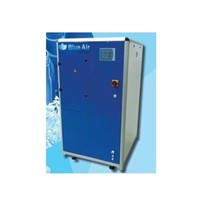Three demands are placed on a properly designed compressed air distribution system: a low pressure drop between the compressor and point of consumption, a minimum of leakage from the distribution piping and efficient condensate separation if a compressed air dryer is not installed.
Keep the pressure drop low between the compressor and point of consumption
These three demands primarily apply to the main pipes, and to the planned compressed air consumption for current needs as well as for the future. The cost of installing larger pipe dimensions as well as fittings than those initially required is low compared to the cost of rebuilding the compressed air piping system later.
The airline network's routing, design and dimensioning are important for the efficiency, reliability and cost of compressed air production. Sometimes a large pressure drop in the pipeline is compensated by increasing the working pressure of the compressor from 7 bar(e) to 8 bar(e), for example.
Fixed compressed air distribution networks should be dimensioned so that the pressure drop in the pipes does not exceed 0.1 bar between the compressor and the most remote point of consumption.
The pressure drop in connecting flexible hoses, hose couplings and other fittings must be added to this. It is particularly important to properly dimension these components, as the largest pressure drop frequently occurs at such connections.
The longest permitted length in the compressed air pipe network for a specific pressure drop can be calculated using the following equation:
- l = overall pipe length (m)
- ?p = permitted pressure drop in the network (bar)
- p = absolute inlet pressure (bar(a))
- qc = compressor Free Air Delivery, FAD (l/s)
- d = internal pipe diameter (mm)
The best solution involves designing a compressed air pipe system as a closed loop ring line around the area in which air consumption will take place. Branch pipes are then run from the loop to the various consumer points. This provides uniform compressed air supply, despite heavy intermittent usage, as the air is led to the actual point of consumption from two directions. This compressed air system design should be used for all installations, except if some points of large air consumption are located at a great distance from the compressor installation. A separate main air pipe line is then routed to these points.
Designing the compressed air piping network
The starting point when designing and dimensioning a compressed air network is an equipment list that details all compressed air consumers, and a diagram indicating their individual locations.
A larger compressed air network can be divided into four main parts:
- Risers: Transport the compressed air from the compressor plant to the consumption area
- Distribution pipes: Split the air across the distribution area.
- Service pipes : Route the air from the distribution pipes to the workplaces.
- Compressed air fittings
Dimensioning the compressed air piping network
The pressure obtained immediately after the compressor can generally never be fully utilized because the distribution of compressed air generates some pressure losses, primarily as friction losses in the pipes and due to the compressed air piping material.
In addition, throttling effects and changes in the direction of flow occur in valves and pipe bends. Losses, which are converted to heat, result in pressure drops.
The equivalent pipe lengths for all the parts of the installation are calculated using a list of fittings and pipe components, as well as the flow resistance expressed in equivalent pipe length. These "extra" pipe lengths are added to the initial straight pipe length. The network's selected dimensions are then recalculated to ensure that the pressure drop will not be too significant. The individual sections (service pipe, distribution pipe and risers) should be calculated separately for large installations.
Air velocity
The most overlooked idea in compressed air piping layout and design is air velocity. Excessive velocity can be a root cause of backpressure, erratic control signals, turbulence and turbulence-driven pressure drop.
The British Compressed Air Society (BCAS) suggests that a velocity of 6m/s or less prevents carrying moisture and debris past drain legs and into controls.
A velocity greater than 9m/s is enough to transport any water and debris in the air stream. Thus, the recommended design pipeline velocity for interconnecting piping and main headers is 6-7m/s or less, and never to exceed 9m/s.
If you are designing a compressed air system, please get in touch with one of the Atlas Copco sales engineers to help design the best and most optimum compressed air distribution system that lowers your operating costs and improves productivity.











-160x160-state_article-rel-cat.png)
























-205x205.jpg)
-205x205.jpg)





